WAVES
The student should be able to:
Explain the concept of a wave;
Explain the terms wave long frequency and velocity of a wave; and
Identify types of waves.
Explain the term refraction, reflection, diffraction and interference of a wave
Mention the applications of refraction, reflection, diffraction and interference of a wave in daily life
Demonstrate the behaviour of waves
Describe the propagation of mechanical waves.
Explain the propagation of electomagnetic waves
Determine the relation between frequency, speed and wavelength of a wave and determine the refractive index of a medium
Identify the sources of sound waves
Explain the concept of audability of sound
Describe the perception of hearing
Explain the concept of echo and reverbaration of sound.
Explain concept of a musical sound;
Identify factors affecting loudness, pitch and quality of a musical sound.
Identify the different musical instruments
Explain the terms stationery wave, nodes and antinodes
Determine the frequency of a musical note
Differentiate between fundamental note and overtones
Explain the concept of resonance as applied in sound waves
Construct a simple musical instrument.
Explain the concept of the electromagnetic spectrum
Identify the main bands of the electromagnetic spectrum
Detect infra-red, visible and ultra violet rays
Wave is a progressive disturbance propagated from a point in a medium (matter) on space without the movement of the points themselves. For Example, light, sound and water waves
Terms Used
- Period: period is the time taken for complete a cycle. It represented by letter T. it SI unit is second (s)
- Amplitude: Amplitude is the maximum displacement of the wave from the equilibrium position. It represented by letter A. it SI unit is metre (m)
- 5Crest: Crest is the point of maximum positive displacement of the wave from the equilibrium position.
- Trough: Trough is the point of maximum negative displacement of the wave from the equilibrium position.
- Wavelength: Wavelength is the distance between two successive or adjacent crests or troughs. It
represented by letter Lambda (A)
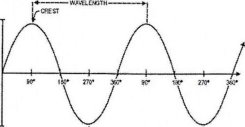
- Frequency: Frequency is the number of crest or trough that passes a given point per unit time. It represented by letter f . Its SI unit is 1 hertz (Hz) = 1 per second (s-1)
Mathematically: = f= 1/T
Wave velocity: Wave velocity is the speed at which the wave moves through a medium.
Or
Wave velocity is the displacement of the wave per unit time. It represented by letter v.
Mathematically;
V = λ/T = λ x 1/T
But: ƒ= 1/T
V=λxf = λƒ
V=λƒ
Example,
From the diagram below, determine the amplitude, period and frequency of the wave.

-0.5
Solution
From the graph
Amplitude, A = 0.5m
Period, T = 0.2
Frequency, f = 1 /T = 1 /0.2 = 5Hz
Example,
From the diagram below, determine the wavelength and velocity of the wave, frequency of the wave is 5Hz
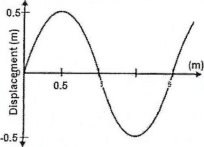
Solution
From the graph
Wavelength, A = 2m Velocity, v = ?
But: Frequency, f = 5Hz
From: V = λf
Then: V = 2 x 5 = 10m/s
V = 10m/s
Types of Waves
There are two types include
- Electromagnetic wave
- Mechanical wave
Electromagnetic Wave
Electromagnetic wave is the kind of waves in which it does not require a medium to transfer energy.
Properties of Electromagnetic Wave
- The disturbance made up of electric and magnetic fields
- can travel through vacuum
Example, visible light and sun rays.
Mechanical Wave
Mechanical wave is the kind of waves in which require a medium to transfer energy.
Properties of Mechanical Wave
- mechanical travel through a medium the particle that make up the medium are disturbed from their rest or equilibrium position
- can travel through medium
- Example, sound wave.
Types of Mechanical Waves.
There are two types which includes
- Transverse wave
- Longitudinal wave
Transverse Wave
Transverse wave is the mechanical wave in which particles of the medium vibrate in a direction perpendicular to the direction of movement of the wave. For Example, water wave.
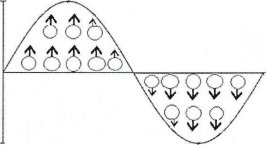
This vibration of medium cause boat on the ocean moves up and down while the waves themselves move toward the shore.
Longitudinal Wave
longitudinal wave is the mechanical wave in which particles of the medium vibrate in a direction parallel to the direction of movement of the wave. For Example, sound wave.
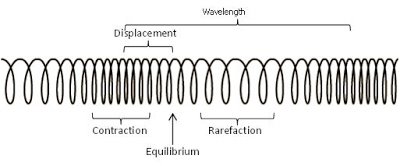
It consist compression where the particles packed closely together and rarefactions where the particles are spread out
Behaviour/Properties of Waves
If waves travel from one to another point it may the following characteristics
Reflection of waves
Refraction of waves
Interference of waves.
Diffraction of waves
Reflection of Waves
When wave encounter a boundary through which it cannot pass it will be reflected. If boundary fixed the reflection is inverted.
If the wave travel from less denser medium to denser medium the reflection will inverted.
Inverted reflected wave Transmitted wave.
If the wave travel from denser medium to less denser medium the reflection will not inverted.
LAWS OF REFLECTION OF WAVES.
The laws of reflection of waves states that
1st. "the incident direction of propagation, the reflected direction of propagation and
the normal all lie in the same plane"
2nd."The angle of incidence equals to the angle of reflection"
NB:
- Direction of waves is represented by an arrow called a ray which drawn perpendicular to wave fronts in straight surface
- If water waves encounter an parabolic (concave/convex) Barrier the waves
Applications of Reflection of Waves
- Reflection of light waves is used in the designing of plane mirror
- Reflection of waves (sound waves) used on measuring distance
- .Sonar system rely on the reflection of sound waves to assist ships in navigating, communicating and detect other vessels
Ripple Tank Experiment
Ripple tank experiment consists of water pool in shallow rectangular dish with a clear glass base, wooden/metal bar for generating water waves
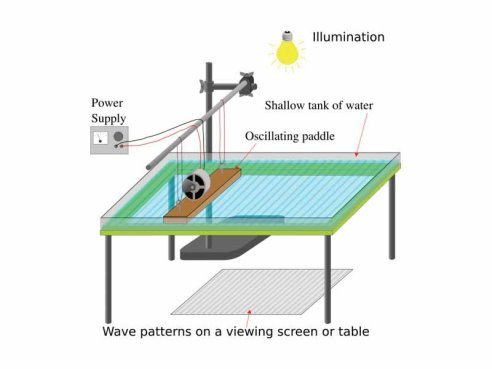
Main Parts of Ripple Tank
The basic components of ripple tank experiment are ripple tank, water, power supply, stroboscope, electric motor, wooden bar (vibrator), bulb and white board or white sheet (screen)
- metal bar (wooden bar)
- Shallow tank of water
- Motor
- Oscillating paddle
- Lamp
- Paper sheet
- Various obstacles. E.g. Laying glass
- stroboscope
Metal bar
A metal bar (wooden bar) is screwed to the electric motor and suspended above the ripple tank with rubber (elastic) bands and touching the water surface.
Shallow tank of water
Shallow tank of water is the source of waves in which an oscillating paddle generates parallel water waves
Motor
The rotating armature (axle) of an electric motor makes the wooden/metal bar to vibrate on water surface and generating ripples
Oscillating paddle
Oscillating paddle is the one in which transform mechanical energy generated by motor by off centre mass to wave energy in a Shallow tank of water
Lamp/ Bulb/ filament
Bulb or filament which used to illuminate the water surface to see the water waves onto the white board or white sheet below the ripple tank.
Paper sheet
Paper sheet used to display shadow of the wave pattern placed under the tank.
Various obstacles
Various obstacles is paced in the tray to observe properties of waves e.g. reflection, refraction, interference and diffraction. Example, laying glass,
Rectangular, barrier, curved,barrier
(concave and convex barrier) etc
Stroboscope
The stroboscope enables the observer to see the waves as stationary
Laying glass
Laying glass used to vary the depth (tray thickness) of the water. This allows observing waves travelling from one to another medium
Power supply
Power supply for electric motor
Refraction of Waves
Refraction of waves involves a change in direction of waves as they travel from one
to another medium due to a chance in speed (v) and wave length (A). It obey Snells law
Diagram:
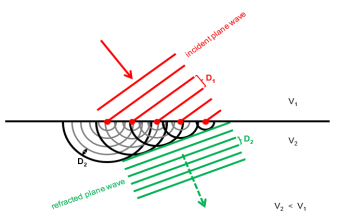
NB:
(a) When wave is refracted into an less media, The frequency of wave increases and vice versa
(b) When wave is refracted into an less median The speed of wave increases and vice versa
(c) When wave is refracted into an less median the wave length of wave increases and vice versa
(d) When wave is refracted into an less median The wavelength of wave does not change (unaltered) and vice versa
Application of Refraction of Waves
It is used in optical instruments which focus or spread light. For Example, microscopes and telescopes
It is used in dispersion of light waves.
lt is used to determine the eyes refractive error
Interference of Waves
Interference of waves involves meets of two or more waves. Interference also known as addition/superposition which result a new wave pattern.
Principle of Superposition
It states that
"The resultant displacement at any points is equal to the sum of the displacements
of different waves at the point"
Nb:
When two different crests meet at the same point in the same direction results greater amplitude than individual, this refers as constructive interference.
When crest and trough meet at the same point in the opposite direction results smaller amplitude than individual, this refers as destructive interference
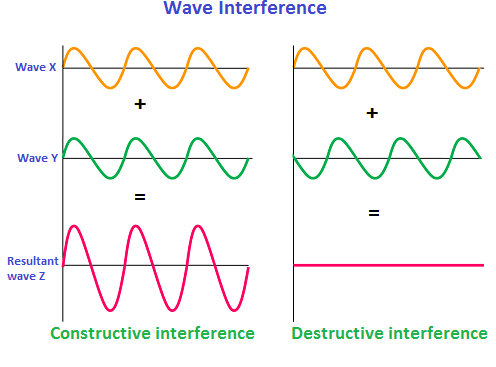
iii. Consider the table below.
| Wave A | Wave B | resultant |
| +1 | +1 | +2 |
| +2 | -1 | +1 |
| -1 | +1 | 0 |
| +1 | -2 | -1 |
| -1 | -1 | -2 |
When waves interfere, the lines of increase disturbance (constructive interference) is called antinodal lines while When waves interfere, the lines of zero disturbance,(destructive interference) is called nodal lines.
Diagram:
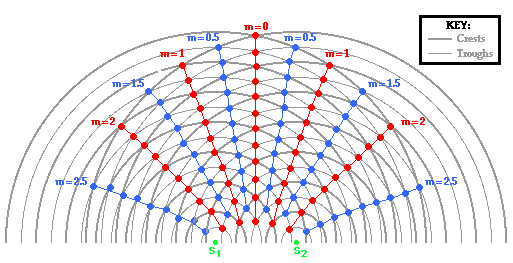
Where:
S1= first wave source
S2= second wave source
Dark circle = crest meet crest Blank circle = trough meet trough Half-dark = crest meet trough
Blue (Lines) = antinodal
Red (Lines) = nodal
Application of Wave Interference
- Creation of hologram. holograph is a photograph of an interference pattern which is able to produce a three dimensional image when suitably illuminated
- Noise reduction system. For Example, earphones capture environment sound which destructed by second computer sound.
- Concert and auditoriums designed to reduce destruction interference by introduce sound absorber
Diffraction of Waves
Wave diffraction is the apparent bend when encounter an obstacle and spread out of wave when they go through a gap.
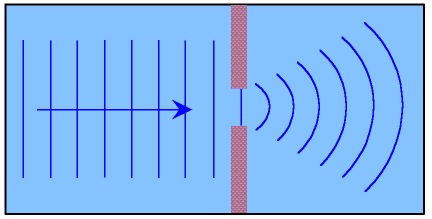
Nb:
- The gap is inversely proportional to wave diffraction (spreading), small the width of gape the large wave diffraction (spreading)
- Diffraction of wave is greater when the wave length and width of gap is the same
- We hear someone sound even she/he behind the building due to diffraction of wave sound
Characteristics of Diffracted Wave
- Wavelength does not change.
- Frequency does not change.
- Speed of diffracted does not change.
- The amplitude of the wave decreases after diffraction.
Factors Affecting Diffraction
The magnitude of diffraction (or angle of diffraction) depends on
- The wavelength
- The size of the opening gap
Applications of Diffraction Of Wave
- It is used in determine the crystal structure of materials
- It is used in measuring the coefficient of thermal expansion, crystalline size and thick of thickness of thin films.
- lt is used in determine the types and phases present in a specimen where the spacing of obstacles (atoms) is between 1 and 3nm
Sound Waves
Sound wave is a longitudinal wave that produced by vibrating object. For Example, turning fork.
Propagation of Sound Wave
Sound travels by vibrating of particles to transfer energy to the next particle until the sound reaches another point.
Question: why solid materials transfer sound faster than liquid/gas
Answer: the molecules/particles of solid materials are packed together
Sources of Sound Wave
Almost everything ranging from people, animals, plants and machines
Musical Instruments
Musical instrument is designed to produce specific types of sounds include guitars, violins, organs, recorders, flutes, drums, marimbas.
Factors Affect Speed of Sound In Air.
Speeds of sound can be affected by the following factors
Temperature
Direction of wind
Humidity
Density of air
Temperature
Sound is the form of kinetic energy. Molecules at higher temperature have more energy, thus they can vibrate faster so sound waves can travel more quickly.
Direction of Wind
Sound will travel faster toward direction of wind while in opposite direction the speed of sound decreased
Wind direction: V α W
Wind in opposite direction: V α![]()
Humidity
Sound is the form of kinetic energy. Molecules at low temperature (humidity) have lower energy, thus they can vibrate slowly so the speed of sound decreased.
Density of Air
Increase in temperature tend to decrease the density of air so increase in density of air tend to decrease speed of sound in air.
Audibility Range
Audibility range is the range of frequency detected by ear.
Nb:
- The ear is most sensitive to sound with a frequency around 3000Hz
- Sound below 20Hz is called Infrasonic sound.
Audio Range Table
| Animal | Audio range (Hz) |
| Chicken | 125 - 2000 |
| Penguin | 100 - 15000 |
| Owl | 200 - 1 2000 |
| Cattle | 23 - 35000 |
| Sheep | 100 - 30000 |
| Dog | 67 - 45000 |
| Cat | 45 - 64000 |
| Rabbit | 360 - 42000 |
| Horse | 55 - 33500 |
| Rat | 500 - 64000 |
| Blue whale | 5 - 12000 |
| Rissos dolphin | 8000 - 100000 |
The human ear.
An organ responsible for conversion of sound energy into mechanical energy and to nerve impulse transmitted to brain for interpretation. It can distinguish amplitude, direction and frequency
Part of Human Ear
It consists three basic parts include
- outer ear
- Middle ear
- Inner ear
Inner ear consists of the cochlea, semicircular canals and the auditory nerve.
- Cochlea

Outer ear consist earflap and the ear canal. Sound reach outer ear in the form of pressure with an alternating pattern of high and low pressure regions.
Middle Ear
Middle ear is air filled cavity that consists of an ear drum and three small interconnected bones Hammer, anvil and stirrup. Eustachian tube connect mouth and middle for regulation of pressure.
Inner Ear
Chochlea
Cochlea is the auditory portion of the inner ear. It consist nerves called cochlea nerve or auditory nerve or acoustic nerve. Auditory nerves are differ in length for unique natural sensitive to particular frequency of vibration
Semicircular Canals
Semicircular canal is filled with fluid known as endolympth. It have nerve which responsible for balancing the body.
Mechanism of Hearing
Earflap collect sound wave, which pass through the ear canal to hit drum which results vibration of interconnected bones where vibrate cochlea fluid through (oval window) results vibration of hair cells which transform mechanical energy to electrical impulse, which transmitted to the brain where they are decoded and interpreted as sound
Echo
echo is the reflected sound when then encounter an obstacle. Since the sound waves goes and bounce back it distance becomes 2d.
Hence speed (v) of sound associated with echo is calculated by
v = 2d/t
Nb:
- Always echo reaches the ear more than 0.1s
- At 250C the speed of sound in air is 340m/s
- From: v = 2d/t
Then: 2d=vxt= 0.1 x340
d = 17m
Therefore: minimum distance an obstacle kept is 17m for echo to be heard.
Reverberation
Reverberation is reechoed sound
Example,
A gun was fired and the echo from a cliff was heard 8s later. How far was the gun from the cliff?
Data given
Time taken by echo, t = 8s
Wave velocity in air, v =
Distance moved by sound, 2d = ?
Solution
From: d = v x t
2d = 1500 x 8
2d = 2800m
d= 1400m
Example : NECTA 2000, QN: 04
- Define an echo
- Name any two factors that affect the speed of sound in air
- Explain briefly why sound produced in hall with many people is heard more clearly than when the hall has few people?
- A person standing 99m from the foot of mountains claps his hands and hears an echo 0.6 second later. Calculate the speed of the sound in the air.
Solution
(c) When a hail has many people, most of the sound (including echoes) is absorbed by clothes and skins of the audience, thus echoes do not occur
Data given
Wave distance, d = 99m
Echo time, t = 0.6s
Sound speed, v = ?
Solution
From: v = 2d/t
v = 2d/t = (2 x 99)/0.6 = 198/0.6 = 330 v = 330m/s
Uses of Echo
Under water echo is used
- To find depth of ocean/ocean
- To detect the submarines.
- To detect large groups of fish.
- To detect the wrecked ships.
- To detect the dangerous rocks
Musical Sounds
Musical sound is the sound musical scale (combination of frequencies) that appealing the human ear
Noise
Noise is the random and non-structured sound musical scale (combination of frequencies) that not appealing to the human ear
Properties of Musical Sounds
The follows is the properties used to describe musical sounds, include
- Loudness
- Pitch
- timbre
Loudness
Loudness is the intensity of the sound as perceived by the human ear. The large the amplitude, the louder the sound.
Pitch
Pitch is a property of sound to which sound can be ordered to scale from high to low. The higher the frequency, the higher the pith produced.
Timbre
Timbre is the quality/colour of sound produced by an instrument. For Example, different instrument produce different sound.
Musical Instruments
Musical instruments are a device constructed/modified for making music.
Category of Musical Instrument
It categories into three groups include
- String instrument
- Percussion instrument
- Wind instrument
String Instrument
String instrument is the instrument produced sound by stretched plunked/bowed/struck string. Example, guitar is plunked, violin is bowed and piano is struck
Percussion Instrument.
Percussion instrument is the instrument produced sound by struck with implement/shaken/rubbed or scrapped. Example, drum, cymbals, tambourine, marimba and xylophone.
Wind Instrument
Wind instrument is the instrument produced sound by blowing. Example, recorders, flutes, vuvuzela and trumpets.
Stationary Waves
A stationary wave is the result when two wave waves travel in opposite direction with the same speed and frequency superposed.
Diagram: crest and trough meet.

Diagram: crest/trough and crest/trough meet.

NB:
i. In string waves their amplitude are alternate between adding together and cancelling
Diagram:
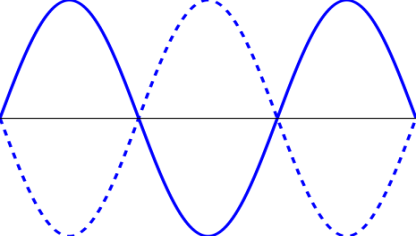
- When adding together producing maximum displacement (amplitude) called antinodes.
- When cancel out producing zero displacement (amplitude) called nodes
- Distance between adjacent antinodes is equal to half wave length, L = A/2
- Distance between adjacent nodes is equal to half wave length, L = A/2vi. distance between a nodes and an adjacent antinodes equal to one quarter, L = A/4
Fundamental Frequency
Fundamental frequency is the lowest frequency of a vibrating object
Fundamental Note
Fundamental note is the note respond to Fundamental frequency
Fundamental Harmonic
A harmonic is defined as an integer (whole number) multiple of the fundamental frequency
Fundamental Overtones
Fundamental overtones is any frequency higher than the fundamental frequency
NB:
- The fundamental note is equal to first harmonic
- The second harmonic is equal to first overtone
- Stationary wave in string have certain fixed wavelength
Consider the diagram below fundamental note

From: L = λ/2 Also: λ = 2L From: V = λƒ Then: V = 2Lƒ1
Diagram: second harmonic

![]()
![]() From: L = 2λ/2
From: L = 2λ/2
Also: λ = 2L/2 From: V = λf2
Then: V = (2Lf2)/2 = Lf2
Diagram: third harmonic
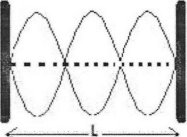
From: L = 3λ/2 Also: λ = 2L/3 From: V = λf3 Then: V = (2Lf3)/3
Generally
From: V = (2Lf3)/3
Three represent the third series of harmonic therefore the formula modified to
V = (2Lfn)/n
Where:
n = nth harmonic
f = frequency
v = wave velocity
L = length of string
fn = frequency of nth harmonic
f = frequency of 1 th harmonic
f2 = frequency of 2nd harmonic
f3 = frequency of 3rd harmonic
Sonometer
Sonometer is an instrument used to study properties of stationary wave.

Factors Affect the String Frequency
There are three factors that affect the frequency of vibrating wire, include
- Length of wire, L
- Tension of the wire, T
- Mass per unit length, p
Length of Wire
The frequency is inversely proportional to the length of wire.
Ƒα1/L……………1
Tension of the Wire
The frequency is directly proportional to the square root of wire tension
ƒα√T……………….2
Mass per Unit Length
The frequency is directly proportional to the square root of mass per unit length
ƒα√1/µ………………..3
Combine three equations
Ƒα1/L√T/µ
- Remove proportionality constant
Ƒ=k1/L√T/µ
WERE k =1/2
Ten; Ƒ=1/21/L√T/µ
Ƒ=1/2x1/L√T/µ
Ƒ=1/2L√T/µ
From: V = (2Lfn)/n make f subject
Ƒ=vn/2L = 1n/2LXV
By compassion
Modify formula
Since: µ =m/l substitute in equation above
Ƒn=n1/2l√LT/m
Where:
n = nth harmonic
fn = frequency of nth harmonic
Example,
A string has a length of 75cm and a mass of 8.2g, the tension in the string is 18N. Calculate the 1st harmonic and 3rd harmonic.
Data given
Length of string, L = 75cm = 0.75m
Mass of string, M = 8.2g = 0.0082kg
Tension of string, T = 18N
1st harmonic, ƒ1 = ?
3rd harmonic, ƒ3 = ?
Solution
From: fn = Ƒn=n1/2l√LT/m
1st harmonic, fi = ?
Ƒn=1x1/20.75√0.75x18/0.0082 =27
fi = 27Hz
3rd harmonic, ƒ3 = ?
Ƒn=3x1/20.75√0.75x18/0.0082 =81
ƒ3 = 81Hz
Example,
The vibration length of a stretched wire is altered at constant tension until the wire oscillates in unison with a turning fork of frequency 320 Hz. The length of a wire is again altered until it oscillates in unison with a fork of unknown frequency. If the two lengths are 90 cm and 65.5 cm, respectively, determine the unknown frequency.
Data given
1st Length of string, Li = 90cm = 0.9m
2nd Length of string, L2 = 65.5cm = 0.655m 1st harmonic, ƒi = 320 Hz
2nd harmonic, ƒ2 = ?
Solution
From: f α1/L
Then: fL= K
Finally: ƒ1L1 = f2L2- make f2 subject ƒ2= (111_1)/LI
12= (320 x 0.9)/0.655 = 440 Hz
f 2 = 440 Hz
Example, NECTA 1995: QN 08
A Sonometer wire of length 40cm between two bridges produces a note of 512Hz when plucked at the midpoint. Calculate the length of the wire that would produce a note of 256Hz with the same tension
Data given
1st Length of string, Li = 40cm = 0.4m 1st harmonic, fi = 512Hz
2nd harmonic, f2 = 256Hz
2nd Length of string, L2 = ?
Solution
From: f α1/L
Then: fL= K
Finally: f i Li = f2L2- make L2 subject L2= (fl Li)/f 2
f2 = (512 x 0.4)/256 = 0.8m L2= 0.8m
Forced Vibration and Resonance
Forced Vibration
Forced vibration is the vibration in a system as a result of impulse received from another system vibrating nearby.
RESONANCE
Resonance is the tendency of a system to oscillate at maximum amplitude at certain frequencies from another system. For Example, turning fork can produce resonance on a piece of wood.
Nb:
Frequency of vibration is equal to the frequency of turning fork (the one cause resonance)
Resonance in Closed Pipe
Consider the diagram below
Diagram:
![]()
Where:
c = end correction
L = λ/4
From: L = λ/4 - without end correction L + c = 3λ/4 - with end correction
Diagram: second harmonic/resonance

From: L = 3λ/4 - without end correction L + c = 3λ/4 - with end correction Diagram: third harmonic/resonance
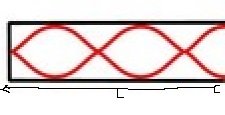
From: L = 5λ/4 - without end correction L + c = 5λ/4 - with end correction
Generally
Without end correction Ln = ((2n - 1 )λ)/4
Without end correction Ln + c = ((2n - 1)λ)/4
Where:
n = nth harmonic
In = frequency of nth harmonic
Example,
A turning fork of frequency 512 Hz is sounded at the mouth of a tube closed at one end with a movable piston. It is found that resonance occurs when the column of air is 18cm long and again when the column is 51cm long. Find wave length and velocity of sound in air.
Data given
Frequency, f = 512Hz
First column length, Li = 18cm = 0.18m.
Second column length, L2 = 51cm = 0.51m.
Wave length of sound in air, A = ?
Velocity of sound in air, v = ?
Solution
From: Li = 1λ/4 - - - - 1
L2 = 3λ/4- - - - 2
Solve simultaneous equation
Equation 2 minus equation 1
L2 — Li = 3λ/4 -1λ/4
L2 — Li = 2λ/4
L2 — Li =
0.51 - 0.18 = λ/2
0.33 = λ/2
= 0.33 x 2 = 0.66m
=0.66m
![]() From: v = λf
From: v = λf
v = 0.66 x 512 = 338 v = 338m/
Therefore the wave length of sound is 0.66m and velocity of sound in air is 338m/s
Example,
In a closed pipe, the first resonance is at 23cm and second at 73cm. determines the wave length of the sound and the end correction of pipe.
Data given
First length, Li = 23cm = 0.23m
Second length, L2 = 73cm = 0.73m
Wave length of sound, λ = ?
End correction of pipe, c = ?
Solution
From: Li + c = 1λ/4 - - - - 1
L2 + c = 3λ/4- - - - 2
Solve simultaneous equation
Equation 2 minus equation 1
L2 + C - Li - C = 3λ/4 -1λ/4
L2- Li = 2λ/4
L2- L1= λ/2
0.73 - 0.23 = λ/2
0.50 = λ/2
λ = 0.5 x 2 = 1.00m
λ= lm
![]() From: equation 1
From: equation 1
L1+ c = 1 λ/4 - make c subject
c = (1λ/4)- Li
c = ((1 x 1)/4)- 0.23
c = 0.25 - 0.23
c = 0.02m
![]() Therefore the end correction of pipe is 0.002m and wave length of sound 0.m
Therefore the end correction of pipe is 0.002m and wave length of sound 0.m
Example, NECTA 1997 QN: 09
(a) Identify three characteristics of sound which distinguish one note from another. Hence state the physical factors which correspondingly define the mention characteristics
(b)A resonance tube whose one end is closed and other open, resonance to a note of frequency 560Hz when the length of the air column is 15cm. determine the wave length of this sound in air. What is the shortest length of the air column which resonates in similar conditions to a note of frequency 1000Hz
Solution
(a) (i) frequency
(ii) Loudness (amplitude)
(iii) Quality of music note (Timbre)
(b) Data given
First Frequency, fi = 560Hz
First Column length, Li = 15cm = 0.15m First Wave length of sound in air, λl = ? Second Frequency, f2 = 1000Hz
Shortest length, 12 = ?
Solution
First: find Wave length of sound in air, λ = ?
From: L = 3λ/4
Al = 41/3 = (4 x 0.15)/3 = 0.12m
= 0.12m
Second: find Shortest length, 12 = ? Note: sound will travel in same speed
From: v = λ1f1 = 560 x 0.12 = 67.2m/s Then: A2 = V/f2 = 67.2/1000 = 0.0672m From: L2 = 3λ2/4 = (3 x 0.0672)/4 = 0.0504
L2 = 0.0504m
Resonance in Opened Pipe
Consider the diagram below
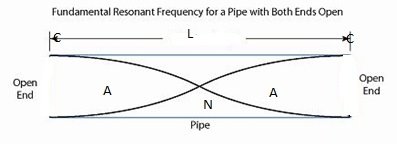
Where:
c = end correction
Since: opened twice end correction doubled
Then: L = λ/2
From: L = λ/2 - without end correction L + c = λ/2 - with end correction
Diagram: second harmonic/resonance

From: L = 2λ/2 - without end correction L + c = 2λ/2 - with end correction
Diagram: third harmonic/resonance
________________________
From: L = 3λ/2 - without end correction
L + c = 3λ/2 - with end correction
Generally
Without end correction Ln = nλ/2
Without end correction Ln + 2c = nλ/2
Where:
n = nth harmonic
In = frequency of nth harmonic
Example,
A turning fork of frequency 250Hz is used to produce resonance in an opened pipe. Given that the velocity of sound in air is 350m/s. find the length of tube which gives
a) First resonance
b) Third resonance
Data given
Sound frequency, f = 250Hz
Sound velocity, v = 350m/s
First resonance Length, Li = ?
Second resonance Length, L2 = ?
Solution
From: Ln = nλ/2
Find wave length first
From: v = λf -make λ subject
A = v/f = 350/250 = 1.4m
(a) First resonance Length, Li = ?
From: L1 = λ/2
L1 = λ/2 = 1.4/2 = 0.7m
L1 = 0.7m
![]() (b)Second resonance Length, L2 = ? From: L2 = 2λ/2
(b)Second resonance Length, L2 = ? From: L2 = 2λ/2
L2 = 2λ/2 = (1.4 x 2)/2 = 2.8/2 = 1.4
L2 = 1.4m
![]() Beats
Beats
Beats is the fall or rise in loudness of sound when two sources of sound of nearly equal frequencies produce sound together.
Formation of Beats
Beats formed when two/more sounds instruments (e.g. forks) of nearly equal pitch are played/sounded together. As a results a regular rise and fall in the loudness occurs as the waves generated by the instruments interfere constructively and destructively respectively.
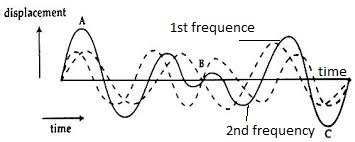
The Beat frequency/number is given by Bf=fi-f2orf2-fi
Example,
A 256Hz turning fork produces sound at the same time with a 249Hz turning fork. What is the beat frequency?
Data given
First frequency,fi = 256Hz
Second frequency,f2 = 249Hz
Beat frequency, Bf = ?
Solution
From: Bf = f2
Bf = fi- f2= 256 249 = 7Hz
Bf = 7Hz
![]() Example, : NECTA 2010, QN: 10
Example, : NECTA 2010, QN: 10
(a) (I) Distinguish between longitudinal wave and transverse wave
(ii) Explain how beats are formed
(b)A light wave is refracted into an optically less median. What change will occur in.
(i) The frequency?
(ii) The speed?
(iii) The wavelength?
(c) (i) what is an echo
(ii) A sound is sent out from the ship and its reflection from the ocean floor returns one second later. Assuming that the velocity of sound in water is 1500m/s. how deep is the ocean?
Data given
Time taken by echo, t = ls
Wave velocity in air, v =
Distance moved by sound, 2d = ?
Solution
From: 2d = v x t
2d = 1500 x 1
2d = 1500m
d= 750m
Example, : NECTA 2011, QN: 06
(a) (i) What is a sonometer?
(ii) Briefly explain when resonance is said to occur.
(b)Two boys are stand 200m apart on one side of a high vertical cliff at the same perpendicular distance from it. When one fires a gun, the other hears the sound 0.6seconds after the flash and the second sound 0.25second after the first sound. Calculate the perpendicular distance of the boys from the cliff
(c) A diagram below illustrates part of the displacement-time graph of a wave travel with velocity of 2m/s.
First sound
Distance of sound to other boy, L = 200m
Time taken to other boy, ti = 0.65s Sound Speed, v = L/ti
v = 200/0.65 = 307.69m/s
v = 307.69m/s
Second sound
Echo time, t2 = 0.65 + 0.255 = 0.85s
Distance of echo, d = ?
From: 2d = v x t2
2d = 307.69 x 0.85 = 261.54
d = 130.77m
Now: perpendicular distance, D = ?
From: Pythagoras theorem
D2 + 1002 = d2
D2 = d2 - 1002= (130.77)2- 1002
D2 = 17100.79 - 10000
D2 = 7100.79 = (84.27)2
D = 84.27m
(c) Data given
Speed, v = 2m/s Amplitude, A = 0.2m
Period, T = 0.1s Frequency, f = ? Wave length, λ = ?
Solution
- The amplitude is 0.2m
- Frequency, f = ?
- From: f = 1/T
f = 1/T = 1/0.1 = 10 f = 10Hz
- Wave length, λ = ?
From: , λ = v/f
λ = v/f = 2/10 = 0.2
λ = 0.2m
Electromagnetic Waves
Electromagnetic wave is the wave travel perpendicularly to both electric and magnetic field. Include
Diagram:
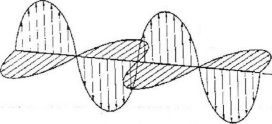
Electromagnetic wave include the follows
- Radio wave
- Microwaves
- Infrared radiation
iv. Visible light
v. Ultraviolet rays
vi. X-rays
vii. Gamma rays
Nb:
- It produced when electrically charged particles oscillate or change energy
- The greater the energy change, the higher the frequency of the resulting wave
- In vacuum propagated in speed of light
Properties of Electromagnetic Waves
It is transverse waves which exhibit the following characteristics
Do not require material medium for travel
It undergoes reflection, refraction, interference and diffraction.
Travel at speed of 3 x108 m/s in vacuum.
They carry no electric charge.
Transfer energy in form of electric & magnetic field.
They obey wave equation, v = λf
Electromagnetic Spectrum
Electromagnetic spectrum is a continuous band of all electromagnetic waves arranged in order of increasing or decrease frequencies or wavelength. It divided into seven regions or bands
Tables of Electromagnetic Spectrum
| Wavelength (m) | Region | Frequency (H) |
| >10-1 | Radio | >3 x 109 |
| 10-1- 10-4 | Micro | 3x109-3x1012 |
| 10-4-10-7 | Infrared | 3x1012- 4.3x1014 |
| 7x10-7-4x10 -7 | Visible | 4.3x1014- 7.5x1014 |
| 4x10-7-10-9 | Ultraviol | 7.5x1014- 3x1017 |
| 10-9-10- 1 | X-rays | 3x1017- 3x1019 |
| <10-11 | Gamm | >3x1019 |
Electromagnetic Spectrum Observation. There are two observations about electromagnetic spectrum include
- It continuous: means each band merges into next and there is no gap between their frequencies
- Some Wave length overlap: in some case there is overlap of wave length so we have to name according to source not the wave length, for Example, X-rays and Gamma rays
Radio Waves
It has the longest wavelength in the electromagnetic spectrum
Category of Radio Wave
It divided into the following
Long waves (LW)
Medium waves (MW)
Short waves (SW), include Very high frequency (VHF) and ultra high frequency (VHF)
Sources of Radio Waves
It produced by;
- Alternating electric currents flowing through in special conductor called antennae
- Special circuits called oscillator.
- Object in space such as planets, comets, stars and galaxies
Detection of Radio Waves
Radio waves are detected using specially designed antennae such as those used in radios and televisions.
Uses of Radio Waves
- Broadcasting of information by radio and television channels is achieved using radio waves.
- Astronomers use large radio telescopes to collect and study radio waves from distant stars and galaxies.
Microwaves
Microwaves have a short wavelength of between 10-4m to about 0.1 m
Sources of Microwaves
Microwaves are produced by oscillation of charges in special antennae mounted dishes. Micro waves are also produced in devices called magnetrons.
Detection of Microwaves
Micro wave can be detected by using special receiver which converts radio wave energy to sound called RADAR (Radio Detection and Ranging)
Uses of Microwaves
Microwaves are used in cooking. In a microwave oven, microwave pass through the food and are absorbed by the food molecules.
Radar system used microwave for detection of position, speed, and other characteristics of remote objects.
Are used in long-distance
communication because they are not affected by clouds or other atmospheric condition.
Infrared Waves
Infrared radiation has frequency of between 1012 and 1014 Hz. It has heating effect
Sources of Infrared Waves
It produced by vibration of atoms and molecules due to their thermal energy. All hot bodies emit infrared radiation
Detection of Infrared Waves
It detected by black bulb thermometer, photographic films, Thermistor and phototransistors.
Uses of Infrared Waves
It is used to cook food in convectional ovens
It is used in remote control, night vision device, fibre-optic telecommunication and security system
Used in infrared lasers that produce infrared beams that can be used to read information on compact discs.
Used in the chemical industry to determine molecular structure and composition of substances by studying their infrared emission or absorption.
Used in the medical field to locate diseased tissues (these areas emit abnormal heat compared to the other areas) and injury by analysing the body tissue and body fluid.
Used for military purposes where infrared imaging devices are used to locate enemy troops in the dark, detect hidden mines, arm caches, to guide anti-aircraft missiles, etc.
Infrared radiation is used to de-ice the wings of aircraft
In industries they are used for welding plastics, drying prints, curing (process of hardening) coatings etc.
Used in locating missing people and people trapped under collapsed buildings (Infrared imaging devices are used)
Used to locate overheating in electric system
Visible Light
Visible light is the range of electromagnetic wave frequencies to which human eyes are sensitive.
Sources Of Visible Light
It produced by electrons transitions within an atom (anything thats hot enough to glow). The sun emits 50% of visible light
Detection of Visible Light
It detected by eyes, photographic films and photocells
Uses of Visible Light
Visible light has very many uses
- Photography
- Vision
- Photosynthesis
Ultraviolet Light
It has short wavelength than visible light
Sources of Ultraviolet Light
- It produced by electrons transitions within an atom but more energetically
- Sun emit ultraviolet radiation which absorbed by ozone layer
- Electric arc used for welding emit ultraviolet radiation
Detection of Ultraviolet Light
It can detect by
- Photographic film (ultraviolet light does not allowed to pass through across ordinary glass until fitted with quartz materials)
- Fluorescent materials which absorb and re-emit ultraviolet light
Uses of Ultraviolet Light
It stimulates of production of vitamin D in human skin
It used in treatment of skin conditions such as psoriasis
lt is used as germicidal agent. Sterilization of food and purification of air and water.
lt used to detect forget document and fake currencies. E.g. bank.
lt is used extensively in astronomical observation
NB:
Ultraviolet light can cause damage of skin, eyes, immune system (mutation) when prolonged exposure.
X-Rays
X-rays Is the electromagnetic wave with short wavelength and very high frequency produced b when fast-moving electrons hit a metal target. It also called ionization radiation because if encounter an atom cause loss of electrons
Sources of X-Rays
It produced when electron accelerated in very high velocity hit a metal target x-rays Tube.
Detection of X-Rays
It can detect by the following methods
By using photographic plate
By using x-ray film in a cassette
By using rare earth element screens
Properties of X-Rays
- travel in straight line at the velocity of light
- they cannot be deflected by electric or magnetic field
- they can produce fluorescence.
- they affect photographic film.
- they penetrate matter but depend on density of matter.
- they ionize gases.
- can be diffracted by crystals
Uses of X-Rays
x-ray photography for diagnosis of denser tissue like bones
it use in treatment of cancer.
used in industry to detect flaws in metal casting and welded joint such as in the aeroplane structure or building structure.
they used in airports and seaport for non-invasive security search.
they are used in the study of the arrangement of atoms in solid.
used to produce images of very small object
Gamma Rays
Gamma ray is more energetically among electromagnetic wave. Also can cause ionization.
Sources of Gamma Rays
- It produced in space such as solar flares, supernovae, neutron star, black holes and active galaxies. All gamma ray from space absorbed by earths atmosphere.
- It produced by radioactive decay of atoms (natural radioactivity)
- lt produced by nuclear fission (in atomic bombs and nuclear reactors)
Detection of Gamma Rays
It can detect by the following methods
- Photographic films
- Geiger-Muller tube
- Cloud chamber
Uses of Gamma Rays
- X-ray photography for diagnosis of denser tissue like bones
- It use in treatment of cancer
- lt used in agriculture to obtain new plant varieties which are disease-resistance and give more yield
Example, NECTA 1995: QN 07
(a) Explain why radio waves are similar to light waves but not sound waves
(b)A radio station transmits a signal of wave 1500m. Calculate the frequency of this signal
Data given
Wave length, A = 1500m
Wave Velocity, v = 3 x108 m/s
But: Frequency, f = ?
From: V = of
Then: f = V/A
f = 3 x108 /1500 = 200000 Hz = 200 KHz f = 200 KHz
Example, NECTA 1998: QN 04
What is diffraction of wave?
Illustrate how plane water wave fronts are diffracted on passing through a narrow gap
(i) Is it possible for light to be diffracted on passing through an open window? (ii) Give an explanation on your answer above
Example, NECTA 1998: QN 08
What is the fundamental frequency of a vibrating string?
Sonometer consists of a taut steel wire fixed between two bridges 100cm apart. Defining the first harmonic, second harmonic, third harmonic and fouth harmonic. Explain ow overtones can be obtained.
WAVES
- A string of length 1.2 m is stretched and the made to vibrate so that a stationary wave consting of two loops is produced.
a) Draw a sketch of the wave
b) Determine the length of the wavelength of the wave
- A wire of length 20cm and mass 1.2g is under a tension of the 120N. determine the wave length of the wave.
a) The fundamental frequency of vibration.
b) The frequency of the third harmonic
- The fundamental frequency of vibration of a string is F. what will be the fundamental frequency of the string be if length is of the of the sting is halved and the tension is increased four times?
- A closed pipe (open at one end) has a fundamental frequency of 400Hz. Calculate:
a) The frequency of the first overtone
b) The fundamental frequency of an open pipe of the same length
- A speaker emitting a note of frequency 250 Hz is placed over the upper end of a vertical tube filled with water. When the water is gradually run down the tube air column resonates initially when the water is gradually run down the tube air column resonates initially when the water level is 9.98 cm below the top of the tube. Determine :
a) The speed of sound in air
b) The end correction
SAMPLENECTA QUESTIONS.
• (a) Define
(i) Amplitude
(ii) Periodic time.
• (b) In a closed pipe, the first resonance is at 23cm and second at 73cm. Determine the wavelength of sound and the End correction.
• Answer; Wavelength , End correction,
• (a) What is meant by the following terms?
(i) Resonance (ii) Overtones
• (b) Briefly explain the following:
(i) The fundamental frequency may alter during the day
(ii) Notes of the same pitch played on violin and a flute sound different.
• (c) The frequency obtained from a plucked string is 400Hz when the tension is 2N. Calculate;
(i) The frequency when tension is 8N
Answer;
(ii) The tension needed to produce a note of
frequency 600Hz.
Answer;
• (a) (i) In longitudinal waves, the particles vibrate to and fro forming region of compressions and rarefactions. Explain the terms compressions and rarefactions. [02]
(ii) State the principle of superposition. [01]
• (b) (i) State two differences between Mechanical waves and Electromagnetic waves. [02] (ii) Calculate the wavelength of green light of frequency
• (c) A stretched string has a fundamental frequency of 600Hz. Determine the new frequency if the tension is doubled and its length is halved. [03]
• (a) (i) What happens when water waves travel from a deep part to a shallow part?
(ii)Define the term interference as used in waves.
• (b) State two conditions for constructive interference to occur.
• (c) A man stands on flat ground some distance from a tall vertical cliff and fires a gun. The report comes 1.9 seconds later. He then walks 200 meters further from the cliff and fires again. The report comes 3.1 seconds later. Calculate the speed of sound and find how far he was originally from the cliff.
• (a) Explain the basic differences between
(i) Mechanical waves and electromagnetic waves. (ii) Longitudinal waves and transverse waves.
• (b) Name two examples of waves that fall into each of the following categories;
(i) Transverse waves. (ii) Mechanical waves.
(iii) Electromagnetic waves
(iv) Longitudinal waves.
© The standing waves that form in some cavity include the fundamental, some overtones and some harmonics. Give the relationship between;
(i) Fundamental frequency and the harmonic frequency.
(ii) The fundamental frequency and the overtone frequency.
www.learninghubtz.co.tz
PHYSICS – WAVES – TOPICAL QUESTIONS.
FORM FOUR.
The following constants may be useful
a) Acceleration due to gravity, g = 10m/s2 or 10N/kg
b) Velocity of sound wave in air, V = 330m/s
c) Velocity of light, c = 3 ![]() 108 m/s
108 m/s
3. For each of the items (i) – (x), fill in the blank spaces by writing the correct answer on the space provided.
- The timbre of sound is also referred to as________________
- The combination of multiple echoes in the listener’s ear produce a louder and more sustained sound called_________________
- _____________ is the kind of waves in which do not required any material medium to transfer energy.
- The phenomenon in which wave encounter a boundary through which it cannot pass and bounce back is called___________
- ___________ is the apparent bend of wave when encounter an obstacle and spread out of the wave when they go through a gap.
- The audibility range is referred to as____________
- The range of electromagnetic wave frequencies to which human eyes are sensitive is called______
- ___________ has a frequency between 1012 Hz and 1014 Hz
- The parts of human ear which are sensitive to particular frequency of vibration is called______
- When two different crests meat at the same point in the same direction results greater amplitude than individual, this refers as____________
SECTION B:
Answer all questions.
4. (a) Define Ection.
(b) Name any two factor that affect the speed of sound in air.
(c) Explain briefly why sound produced in a hall with many people is heard more clearly than when the hall has few people.
(d) A person standing 99m from the foot of mountain claps his hands and hears an echo 0.6second later. Calculate the speed of sound in air.
5. (a) (i) In a longitudinal waves, the particles vibrate to and for forming region of compressions and rarefactions.
Explain the terms compressions and rarefactions.
(ii) State the principle of super position.
(b) (i) State two differences between mechanical waves and electromagnetic waves.
(ii) Calculate the wavelength of green light of frequency 5.0 ![]() 1014 Hz.
1014 Hz.
(c) A stretched string has a fundamental frequency of 600Hz. Determine the new frequency if the tension is doubled and its length is halved.
6. (a) Define
- Amplitude
- Periodic time
(b) In a closed pipe, the first resonance is at 23cm and second at 73cm. Determine the wavelength of the sound and the End correction.
7. (a) What is meant by the following terms?
- Resonance
- Overtones
(b) Briefly explain the following.
(i) The fundamental frequency may alter during the day.
(ii) Notes of the same pitch played on violin and a flute sound different.
(c) The frequency obtained from a plucked sting is 400Hz when the tension is 2N. Calculate:
(i) The frequency when the tension is 8N.
(ii) The tension needed to produce a note of frequency 600Hz.
8. (a) (i) What is a sonometer?
(ii) Briefly explain when resonance is said to occur?
(b) Two boys at 200m a part stand on one side of a high vertical cliff at the same perpendicular distance from it. When one fires a gun, the other hears the sound 0.6seconds after the flash and the second sound 0.25seconds after the first sound. Calculate the perpendicular distance of the two boys from the cliff.
(c) Figure 1 illustrates part of the displacement time graph of a wave travelling across water at a particular place with a velocity of 2m/s. Calculate:-
- The amplitude
- The frequency
- The wavelength.
9. (a) (i) Distinguish between longitudinal and transverse waves.
(ii) Explain how beats are formed.
(b) A light wave is refracted into an optically less medium. What change will occur in:-
- Frequency
- Speed
- Wavelength
(c) (i) What is an echo?
(ii) A sound is sent out from the ship and its reflection from the floor of the ocean returns over second later. Assuming that the velocity of sound in water is 1500m/s. How deep is the ocean?
SECTION C.
Answer one question from this section.
10. (a) Explain the following
(i) Wavelength
(ii) Frequency for sound.
(b) The velocity of sound in air is 330m/s. Find the wave length in water of sound wave of frequency 660Hz if the velocity of sound in water is 1.32km/s.
(c) A sonometer wire of length 40cm between two bridges produces a note of 512Hz when plucked at the mid – point. Calculate the length of the wire that would produce a note of 256Hz with the same tension.
11. (a) A sonometer consists of a tant steel wire fixed between two bridges 100cm a part. Defining the first harmonic (2f), second harmonic (3f), third harmonic (4f) and fourth harmonic (5f0) explain how overtones can be obtained.
12. (a) (i) Define the term fundamental frequency.
(ii) How does the size of the gap in barrier affect the diffraction of waves?
(b) (i) State two ways in which visible light differ from radio waves.
(ii) List two applications of gamma rays.
Hub App
 For Call,Sms&WhatsApp: 255769929722 / 255754805256
For Call,Sms&WhatsApp: 255769929722 / 255754805256
 For Call,Sms&WhatsApp: 255769929722 / 255754805256
For Call,Sms&WhatsApp: 255769929722 / 255754805256
WHATSAPP US NOW FOR ANY QUERY
App Ya Learning Hub Tanzania






